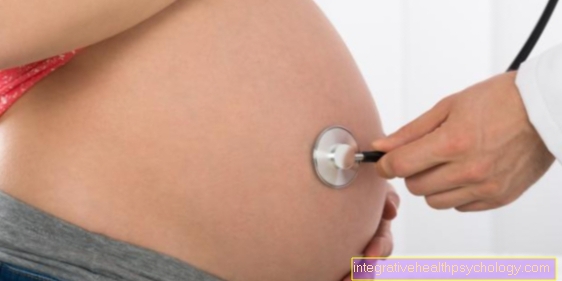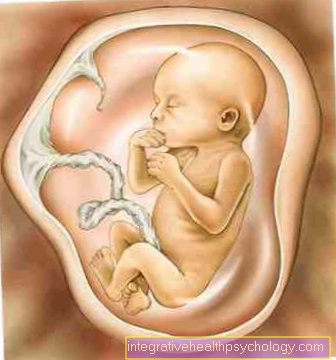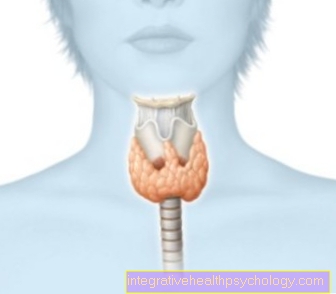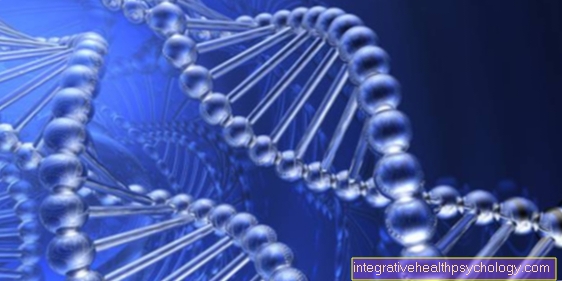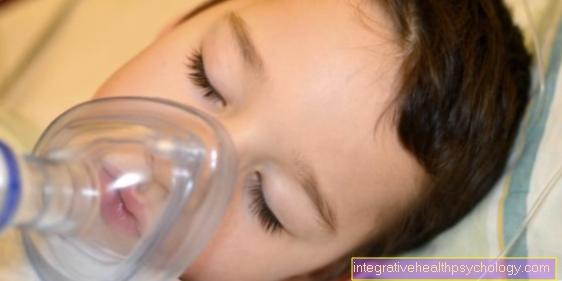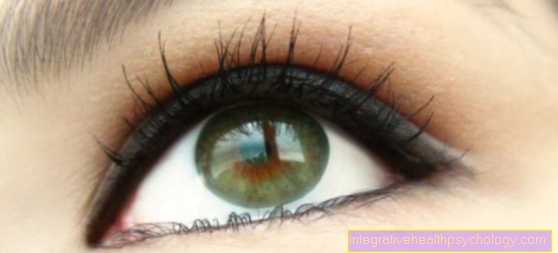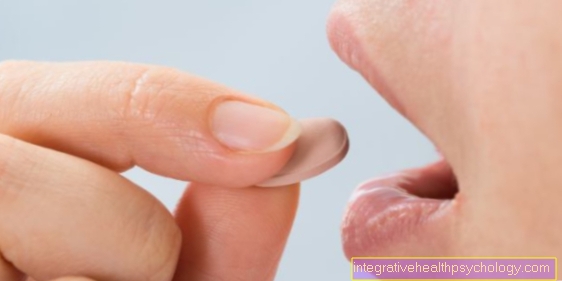Pain in the labia / clitoris
definition
Pain in the labia or clitoris occurs in many women during their lifetime. The spectrum can range from mild, short-lasting pain to severe, chronic pain. Changes in the body and especially in the genital area are often a cause for concern. Pain can be triggered by a variety of processes and diseases.

What is normal / what is no longer normal?
Pain in the genital area and thus also in the labia and clitoris should not be normal. Especially if this pain persists, it is often a sign of a pathological process. Short-term pain can occur after intense or frequent sexual intercourse due to irritation. If the pain subsides within a day and is not too severe, it is usually nothing to worry about.
Long-lasting pain can be triggered by inflammation in the genital area. Often there is one Bartholinitis, an inflammation of the duct of the Bartholin's gland. This can sometimes be very painful. Other infections with fungi, viruses, bacteria or parasites can also trigger pain. These diseases are often sexually transmitted diseases.
Read more about this under Symptoms of Bartholinitis
In rarer cases, benign and malignant changes can also be the cause of pain. Vulvar carcinoma and its precursor, vulvar intraepithelial neoplasia (VIN) can trigger chronic pain, especially at an advanced stage.
Read more about this under Vulvar cancer
Natural processes can also result in pain. During menopause, vaginal dryness often occurs in many women, which can sometimes be painful. However, vaginal dryness can also occur outside of menopause. The cause is usually a lack of estrogen. A so far rare diagnosis is the so-called vulvodynia, chronic pain in the genital area for which there are no obvious physical causes.
Read more about this under
- Inner labia is bigger than outer - what to do?
- The inner labia
- Signs of menopause
- Vaginal dryness
Concomitant symptoms
Depending on the cause, the accompanying symptoms can also vary.
Bartholinitis can lead to an abscess. This is a cavity filled with pus. In this case, there are other general signs of inflammation, such as swelling up to the size of an egg in the back third of the labia, reddening and warming of the skin.
Read more about this under Abscess in the genital area - what helps?
Inflammation in the vaginal area can lead to itching, burning, reddening, pain when urinating and / or sexual intercourse and possibly changes in the vaginal discharge. The inguinal lymph nodes may also be enlarged. Depending on the pathogen, typical symptoms such as whitish deposits with a fungal infection or blisters with a herpes virus infection can occur.
Benign changes can lead to skin changes such as whitish, shiny skin and reddening of the skin, itching, burning irritation, sensation of wetness, warts and discomfort during intercourse. Malignant changes can lead to itching long before visible changes. Burning and swelling can also occur. Dark skin changes and whitish mucous membranes are another sign of malignant changes.
A lack of estrogen primarily triggers a dry vagina. This manifests itself as itching, burning sensation and problems with sexual intercourse.
Read about this too
- Eczema in the genital area - causes, treatment & more
- Boils in the genital area - how it is treated
diagnosis
A gynecological examination is necessary to diagnose pain in the labia and / or clitoris. In advance, the doctor will talk about the current symptoms. In the examination, the outer and inner vagina is examined and felt and smears are taken.
A visual diagnosis is usually sufficient to diagnose Bartholinitis, as the appearance is very clear. In the case of other inflammations, the pathogen is detected with the help of the smear.
In order to exclude benign and malignant changes, samples are taken from the respective region in order to detect a cell change.
If the vagina is dry, a blood test will be done to check for a lack of estrogen.
Vulvodynia is a diagnosis of exclusion if no cause has been found gynecologically, neurologically, dermatologically, or orthopedically.
Treatment / therapy
For bartholinitis, the therapy of choice is what is known as Marsupialization. A small incision is made in the swelling, the edges of the Bartholin glands are folded outwards and sutured to the labia. If there is an abscess, the pus is drained and, if necessary, tested for pathogens.
Read more about this under Treatment of bartholinitis
In the case of inflammation in the vaginal area, the therapy depends on the particular pathogen. For herpes infections, antivirals such as Acyclovir Used locally or in severe cases in tablet form, fungal infections are treated with antimycotics such as Clotrimazole treated. In the case of bacterial inflammation, the choice falls on antibiotics such as Metronidazole in tablet or ointment form. If necessary, the sexual partner must also be treated if it is a matter of sexually transmitted diseases.
Read more on the topic: What drugs are there for vaginal thrush?
Depending on the type of benign changes, symptomatic corticosteroid creams can be used. Warts are first treated with the antiviral drug imiquimod, and then with the help of CO2 laser, cold therapy (Cryotherapy) or a noose.
For the therapy of malignant changes, the therapy depends on the stage of the. In preliminary stages, removal by laser or surgery is performed. In the case of carcinomas, these are cut out as widely as possible and, depending on the location of the tumor, either radio or chemotherapy takes place.
In the case of vaginal dryness due to a lack of estrogen, creams, suppositories or gels that are applied topically help in most cases. In more severe cases, for example during the menopause, when other symptoms arise, hormone therapy with progestin-estrogen preparations can be used.
Read more about this under
- Homeopathy for menopause
- Medication for menopause
There is as yet no causal therapy for the treatment of vulvodynia. Creams with estrogens or anesthetics can be applied locally and pain killers can be taken for chronic pain. Pelvic floor biofeedback and neuromodulation are also used in these cases.
Duration
Depending on the cause, the duration of the pain is difficult to estimate.
With inflammation, the pain often develops along with other symptoms and gets worse within a few days. Pain caused by irritation usually occurs when touched or moved and disappears again when you are at rest.
Tumor pain can develop consistently over weeks. In the early stages, in particular, carcinomas are usually symptom-free. Pain caused by vaginal dryness, especially during menopause, can develop slowly to the point of no menstruation. The pain may go away on its own after a while. As a rule, however, they do not stop until the cause has been treated.
Vulvodynia pain can be very diverse. They can only occur when there is irritation, such as sexual intercourse, but also with the slightest movement. Since this is a chronic pain disorder, the pain usually only improves with pain therapy.
When should i go to the doctor?
As pain in the genital area is often caused by a variety of clinical pictures, it is advisable to consult a doctor if you are in pain. This is especially necessary if the pain has lasted for a few days or even weeks or is particularly severe. Other symptoms such as itching, difficulty urinating or swelling indicate a more complex disease. Since many diseases in the genital area do not heal on their own but require therapy, an examination by the treating gynecologist is important. This can prevent complications from inflammation or identify malignant changes earlier.





